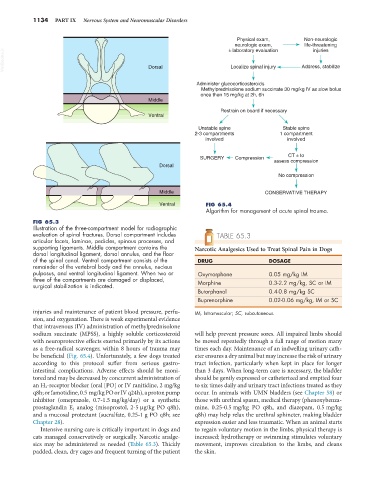Page 1162 - Small Animal Internal Medicine, 6th Edition
P. 1162
1134 PART IX Nervous System and Neuromuscular Disorders
Physical exam, Non-neurologic
neurologic exam, life-threatening
injuries
± laboratory evaluation
VetBooks.ir Dorsal Localize spinal injury Address, stabilize
Administer glucocorticosteroids
Methylprednisolone sodium succinate 30 mg/kg IV as slow bolus
once then 15 mg/kg at 2h, 6h
Middle
Restrain on board if necessary
Ventral
Unstable spine Stable spine
2-3 compartments 1 compartment
involved involved
CT ± to
SURGERY Compression
assess compression
Dorsal
No compression
Middle CONSERVATIVE THERAPY
Ventral FIG 65.4
Algorithm for management of acute spinal trauma.
FIG 65.3
Illustration of the three-compartment model for radiographic
evaluation of spinal fractures. Dorsal compartment includes TABLE 65.3
articular facets, laminae, pedicles, spinous processes, and
supporting ligaments. Middle compartment contains the Narcotic Analgesics Used to Treat Spinal Pain in Dogs
dorsal longitudinal ligament, dorsal annulus, and the floor
of the spinal canal. Ventral compartment consists of the DRUG DOSAGE
remainder of the vertebral body and the annulus, nucleus
pulposus, and ventral longitudinal ligament. When two or Oxymorphone 0.05 mg/kg IM
three of the compartments are damaged or displaced,
surgical stabilization is indicated. Morphine 0.3-2.2 mg/kg, SC or IM
Butorphanol 0.4-0.8 mg/kg SC
Buprenorphine 0.02-0.06 mg/kg, IM or SC
injuries and maintenance of patient blood pressure, perfu- IM, Intramuscular; SC, subcutaneous.
sion, and oxygenation. There is weak experimental evidence
that intravenous (IV) administration of methylprednisolone
sodium succinate (MPSS), a highly soluble corticosteroid will help prevent pressure sores. All impaired limbs should
with neuroprotective effects exerted primarily by its actions be moved repeatedly through a full range of motion many
as a free-radical scavenger, within 8 hours of trauma may times each day. Maintenance of an indwelling urinary cath-
be beneficial (Fig. 65.4). Unfortunately, a few dogs treated eter ensures a dry animal but may increase the risk of urinary
according to this protocol suffer from serious gastro- tract infection, particularly when kept in place for longer
intestinal complications. Adverse effects should be moni- than 3 days. When long-term care is necessary, the bladder
tored and may be decreased by concurrent administration of should be gently expressed or catheterized and emptied four
an H 2 -receptor blocker (oral [PO] or IV ranitidine, 2 mg/kg to six times daily and urinary tract infections treated as they
q8h; or famotidine, 0.5 mg/kg PO or IV q24h), a proton pump occur. In animals with UMN bladders (see Chapter 58) or
inhibitor (omeprazole, 0.7-1.5 mg/kg/day) or a synthetic those with urethral spasm, medical therapy (phenoxybenza-
prostaglandin E 1 analog (misoprostol, 2-5 µg/kg PO q8h), mine, 0.25-0.5 mg/kg PO q8h, and diazepam, 0.5 mg/kg
and a mucosal protectant (sucralfate, 0.25-1 g PO q8h; see q8h) may help relax the urethral sphincter, making bladder
Chapter 28). expression easier and less traumatic. When an animal starts
Intensive nursing care is critically important in dogs and to regain voluntary motion in the limbs, physical therapy is
cats managed conservatively or surgically. Narcotic analge- increased; hydrotherapy or swimming stimulates voluntary
sics may be administered as needed (Table 65.3). Thickly movement, improves circulation to the limbs, and cleans
padded, clean, dry cages and frequent turning of the patient the skin.

